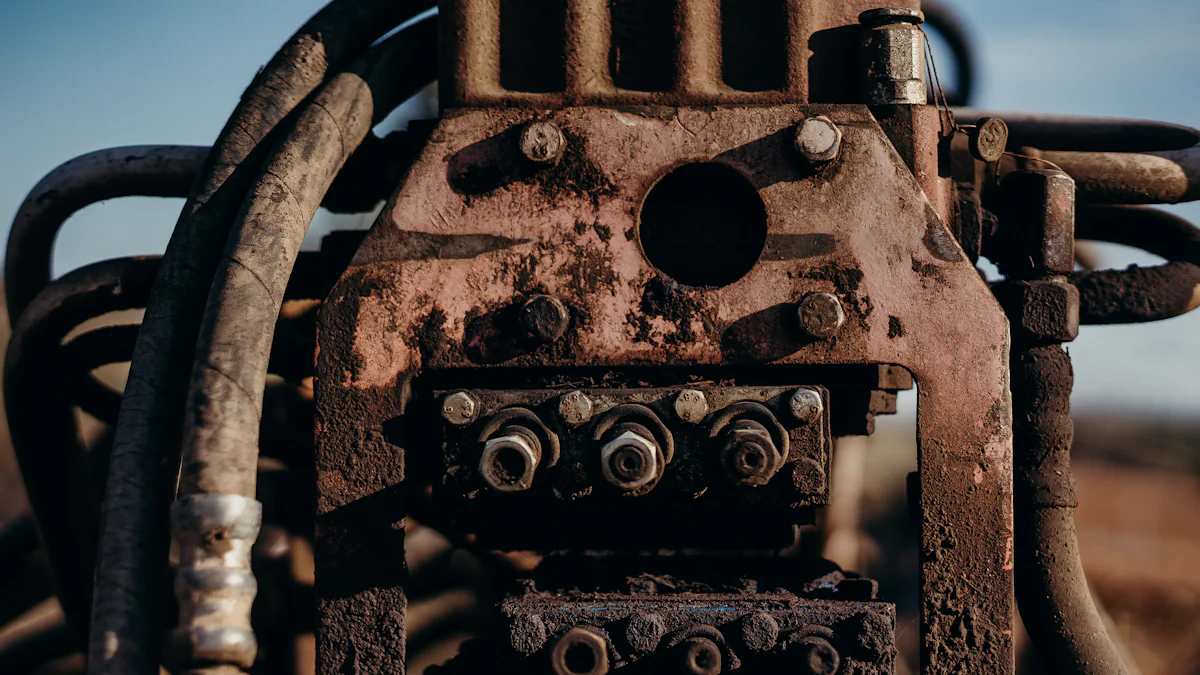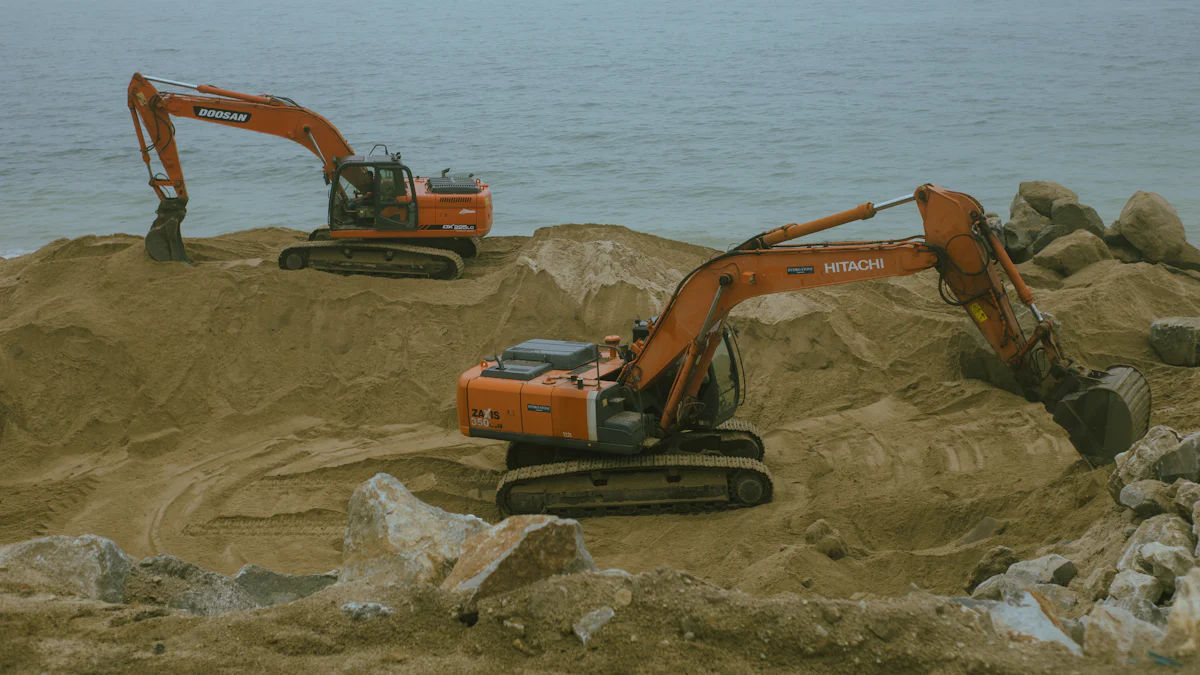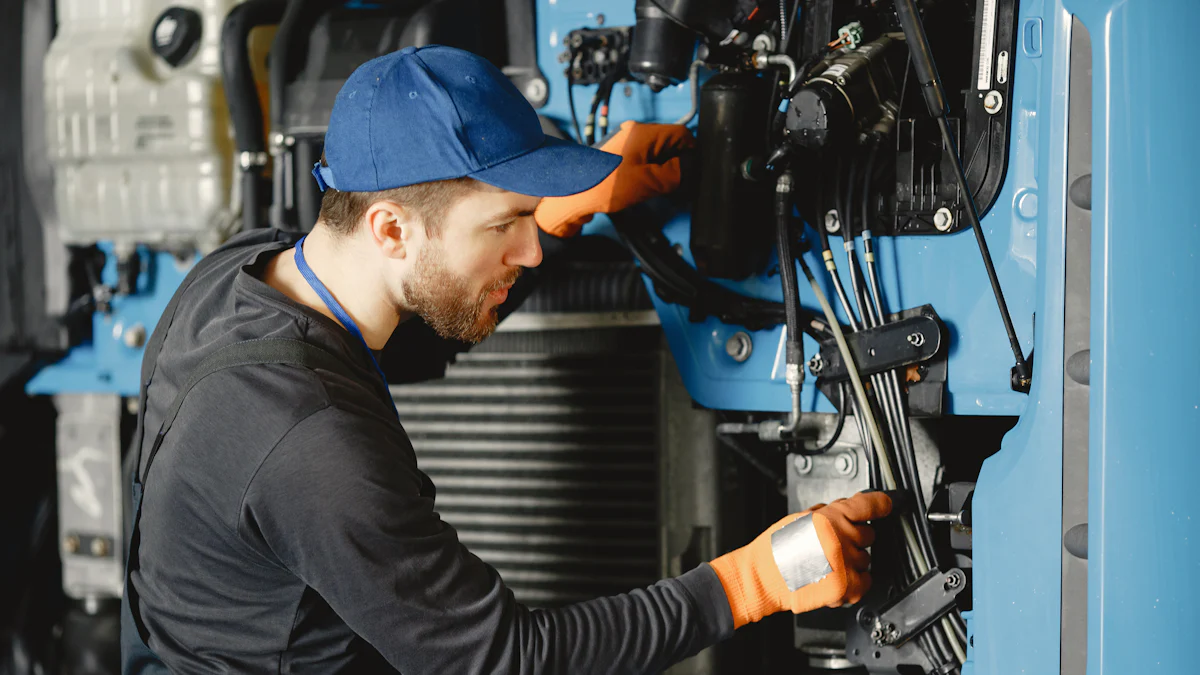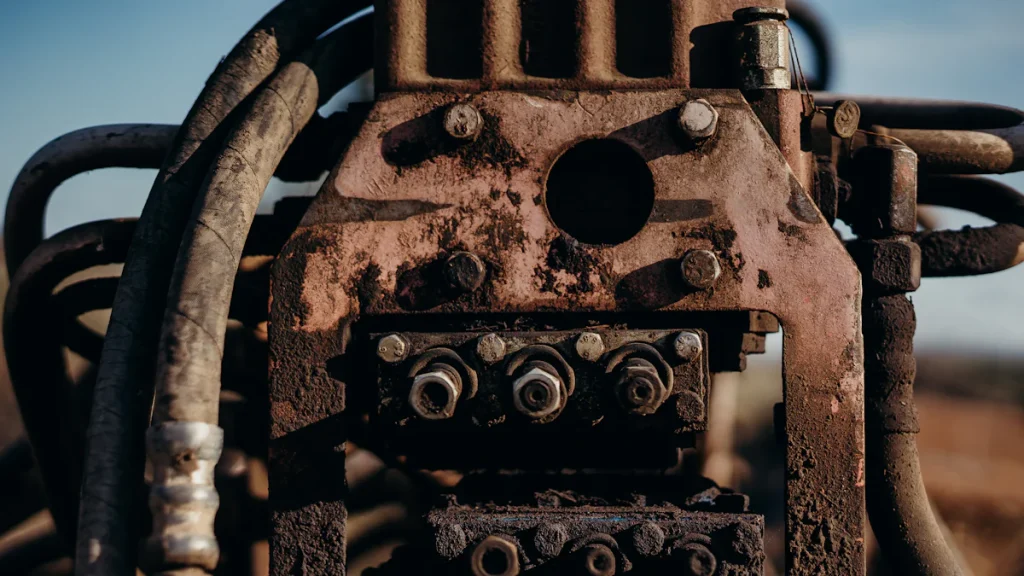
Maintaining your hydraulic excavator’s efficiency and safety depends on identifying and replacing worn parts promptly, including knowing the hydraulic excavator parts name. Damaged components can lead to reduced performance and even compromise operator safety. Replacing these parts on time prevents further damage to other systems and ensures smooth operation. High-quality replacement parts, such as those from YNF Machinery, offer unmatched durability. They enhance load capacity, reduce downtime, and minimize risks on job sites. By choosing reliable components, you safeguard your equipment and maintain its peak performance for demanding tasks.
Key Takeaways
Check the machine often to find damaged parts early. This avoids big repairs and keeps it working well.
Use proper tools, like wrenches and gauges, to safely change excavator parts.
Buy good-quality parts from trusted sellers, like YNF Machinery, to make the machine work better and avoid delays.
Follow safety rules, like lockout/tagout, to stay safe when fixing heavy machines.
Keep your workspace clean and tidy to work faster and avoid accidents during repairs.
Identifying Worn or Damaged Hydraulic Excavator Parts Name

Common Signs of Wear and Tear
Cracks, dents, and visible damage on components
You can often spot worn hydraulic excavator parts by looking for physical damage. Cracks, dents, or other visible issues on components like the final drive casing or hydraulic cylinders indicate wear. These signs usually result from heavy use or impacts during operation. Regularly inspecting these areas helps you catch problems early and avoid costly repairs.
Leaks or fluid stains around hydraulic systems
Hydraulic fluid leaks are another common sign of wear. Puddles of fluid under your excavator or stains near hydraulic hoses and seals suggest worn-out seals or cracks in the system. Ignoring these leaks can lead to reduced hydraulic pressure and performance issues. Addressing leaks promptly ensures your excavator operates efficiently.
Performance Indicators of Faulty Parts
Reduced power or sluggish operation
When your excavator struggles to perform tasks, it may signal internal wear or hydraulic issues. Sluggish movement, difficulty steering, or weak final drive motors often point to low hydraulic fluid pressure or worn components. Monitoring performance changes helps you identify and replace faulty parts before they fail completely.
Unusual noises like grinding or hissing
Strange sounds during operation can also indicate problems. Grinding or clicking noises from the final drive area may mean damaged gears or bearings. Hissing sounds often suggest air in the hydraulic system, which can lead to overheating. Paying attention to these noises helps you pinpoint issues quickly.
Inspection Techniques for Accurate Diagnosis
Routine visual inspections and checklists
Performing regular visual inspections is essential for maintaining your excavator. Check hydraulic hoses, retaining pins, and tool shanks weekly. Inspect hydraulic fluid levels, engine oil, and coolant daily. Monthly checks for bushings and pivot points ensure all parts remain in good condition. These routine inspections help you identify worn hydraulic excavator parts name early.
Using diagnostic tools to measure hydraulic pressure
Diagnostic tools like pressure gauges provide precise measurements of hydraulic pressure. Use gauges with ranges of 0-3500PSI, 0-5800PSI, and 0-8600PSI to test your system. Interchangeable couplings make these tools compatible with most excavators. Accurate readings help you detect issues like low pressure or cavitation, ensuring timely repairs.
Tools and Preparation for Replacing Hydraulic Excavator Parts
Essential Tools for Replacement
Wrenches, screwdrivers, and pliers
You need a variety of basic tools to replace hydraulic excavator parts effectively. Wrenches and sockets are essential for loosening and tightening bolts and nuts. Screwdrivers, both flathead and Phillips, help remove smaller screws. Pliers are useful for gripping, bending, or cutting wires and small components. A torque wrench ensures bolts are tightened to the correct specifications, preventing over-tightening or loosening during operation. For hydraulic systems, specialized tools like hydraulic hose tools and seal pullers are indispensable. A rubber mallet can also assist in gently tapping parts into place without causing damage.
Hydraulic pressure gauges and diagnostic tools
Diagnostic tools, such as hydraulic pressure gauges, are critical for identifying issues before replacing parts. These tools measure hydraulic pressure accurately, helping you confirm whether a component is faulty. Interchangeable couplings make these gauges compatible with most excavators. Using the right tools ensures precision and reduces the risk of errors during the replacement process.
Safety Gear and Precautions
Gloves, goggles, and steel-toe boots
Safety should always come first when working on heavy machinery. Wear safety gloves to protect your hands from sharp edges, hot surfaces, and chemical exposure. Safety goggles or glasses shield your eyes from debris, dust, or hydraulic fluid splashes. Steel-toe boots provide protection against heavy objects that might accidentally fall. A hard hat and high-visibility vest further enhance safety, especially in busy or low-light work environments.
Lockout/tagout procedures for safety
Before starting any replacement work, follow lockout/tagout procedures. Turn off the excavator and disconnect the battery to prevent accidental starts. Stabilize the machine by parking it on a flat surface and engaging the parking brake. Use wheel chocks to prevent movement. These steps ensure a safe working environment and reduce the risk of injuries.
Preparing Your Workspace
Organizing a clean and stable area
A well-organized workspace improves efficiency and safety. Clear the area of unnecessary tools, debris, or obstacles. Arrange your tools and replacement parts within easy reach using a tool organizer or tray. Stabilize the excavator on a flat surface to prevent movement during repairs. A clutter-free workspace minimizes the risk of accidents and misplaced tools.
Ensuring proper lighting and accessibility
Good lighting is crucial for spotting small details and avoiding mistakes. Use portable work lights if natural lighting is insufficient. Ensure the workspace is easily accessible, allowing you to move around the excavator without difficulty. Proper preparation of your workspace helps you complete the replacement process smoothly and efficiently.
Step-by-Step Guide to Replacing Hydraulic Excavator Parts Name

Replacing Hydraulic Cylinders with YNF Machinery Seal Kits
Removing the damaged cylinder
Start by securing your excavator on stable ground. Relieve hydraulic pressure from the system to prevent accidents. Disconnect hydraulic lines and fittings attached to the cylinder. Use wrenches and seal pullers to remove bolts and avoid damaging nearby components. Carefully detach the cylinder, ensuring you document the sequence of disassembly. This step helps you reassemble the parts correctly later. Clean the cylinder and inspect for wear or damage. Replace seals and O-rings with YNF Machinery’s high-quality seal kits to ensure a leak-proof system.
Installing the new cylinder and testing for leaks
Position the new cylinder in place, aligning it with the mounting points. Reattach hydraulic lines and fittings, ensuring proper torque specifications. Lubricate seals and components with recommended hydraulic fluid to prevent friction. Once installed, pressure-test the cylinder to check for leaks. Conduct operational checks to verify smooth movement and alignment. Adjust settings as needed to optimize performance.
Replacing Tracks and Couplings
Detaching old tracks and couplings
Drain oil from the hydraulic system and disconnect hoses and electrical connectors. Remove track pins and bolts using appropriate tools. Lift the old track off carefully to avoid damaging sprockets or idlers. For couplings, loosen bolts and detach the worn component.
Aligning and installing new components
Align the new track with the sprocket and idler. Insert track pins and tighten them securely. Adjust track tension using a grease gun until the track moves freely. For couplings, clean the mounting area and align bolt holes carefully. Tighten bolts to the manufacturer’s specifications to ensure proper alignment and avoid leaks.
Replacing Excavator Engine Parts
Disconnecting worn engine parts
Identify faulty engine parts by checking for signs like excessive heat, smoke, or rough idling. Disconnect the battery and remove the damaged components, such as pistons or gaskets. Use the correct tools to avoid damaging surrounding parts.
Installing new parts and ensuring compatibility
Install new engine parts, ensuring they match your excavator model. Follow torque specifications and lubricate components as needed. Reconnect the battery and test the engine for smooth operation. Regular maintenance of engine parts extends the lifespan of your excavator and prevents costly repairs.
Tips for Sourcing High-Quality Replacement Parts
Why Choose YNF Machinery for Hydraulic Excavator Parts
Rigorous quality inspections and certifications
You should always prioritize parts that undergo strict quality checks. YNF Machinery ensures every component meets or exceeds industry standards. Their hydraulic cylinder seal kits, for example, are crafted from high-grade materials like NBR and FKM, which prevent leaks and ensure durability. These rigorous inspections guarantee that the parts you purchase will perform reliably under extreme conditions.
Competitive pricing and global availability
YNF Machinery offers competitive pricing without compromising on quality. Their low minimum order quantities make it easier for you to stock essential parts. With over 35 years of experience, YNF Machinery has built a global network, ensuring you can access their products wherever your project is located. This combination of affordability and accessibility makes them a trusted partner for excavator owners worldwide.
Benefit | Description |
|---|---|
Durability | High-quality seal kits prevent leaks and ensure long-lasting performance. |
Efficiency | Regular maintenance of hydraulic components enhances efficiency. |
Safety | High-quality parts minimize equipment failure, ensuring a safer environment. |
Cost-effectiveness | Investing in quality parts reduces the need for frequent replacements. |
Verifying the Quality of Parts
Checking manufacturer certifications
Always verify that the parts you purchase come with proper certifications. Look for compliance with OEM standards, as these ensure compatibility and performance. YNF Machinery provides documentation that validates the quality of their products, giving you peace of mind when sourcing replacement parts.
Inspecting materials and build quality
Examine the materials used in the parts. High-grade rubber, reinforced steel, and other durable materials indicate reliability. For example, YNF Machinery’s couplings are designed to handle misalignments and vibrations, ensuring smooth power transmission. Inspecting these details helps you avoid substandard components that could fail prematurely.
Avoiding Counterfeit Products
Purchasing from reputable suppliers like YNF Machinery
Counterfeit parts can compromise your excavator’s performance and safety. To avoid this, purchase from trusted suppliers. YNF Machinery’s reputation for quality and reliability makes them a dependable choice. Their extensive dealer network ensures you receive genuine parts tailored to your needs.
Ensuring warranty and return policies
Always check the warranty and return policies before making a purchase. YNF Machinery offers warranties on their products, reflecting their confidence in quality. A clear return policy also protects you in case of any issues, ensuring a risk-free buying experience.
️ Tip: Investing in high-quality parts not only enhances your excavator’s performance but also reduces long-term costs by minimizing downtime and repairs.
Maintenance Tips to Extend the Lifespan of Excavator Parts
Cleaning and Lubrication
Removing dirt and debris after use
Keeping your excavator clean prevents dirt and debris from damaging critical components. After each use, remove mud, dust, and grime from the undercarriage, hydraulic hoses, and pivot points. Pay special attention to the bucket teeth and tracks, as these areas often accumulate the most debris. Conduct daily walkaround checks to inspect engine oil, hydraulic fluid, and coolant levels. Regular cleaning ensures your machine operates efficiently and reduces wear on moving parts.
Applying appropriate lubricants to moving parts
Lubrication is essential for maintaining smooth operation and preventing friction damage. Use manufacturer-recommended greases and oils to ensure compatibility with your excavator. Regularly grease all pivot points, including the boom, arm, and bucket joints. Check the track tension and adjust it according to the operator’s manual. Proper lubrication not only extends the lifespan of components but also enhances overall performance.
️ Tip: Inspect bucket teeth for wear during cleaning. Replace or rotate them as needed to maintain digging efficiency.
Regular Inspections and Adjustments
Monitoring hydraulic fluid levels and quality
Check hydraulic fluid levels daily to ensure proper operation. This is especially important during summer when high temperatures can cause fluid loss. Monitor the fluid’s color and consistency to detect contamination or degradation. Replace hydraulic fluid every 2,000 hours or as recommended by the manufacturer. Keeping fluid levels and quality in check prevents operational issues and extends the life of hydraulic components.
Checking for loose bolts or connections
Loose bolts and connections can lead to equipment failure. Inspect all fasteners, including those on the undercarriage, boom, and engine, during routine maintenance. Tighten any loose bolts to the specified torque. Regularly inspect belts, hoses, seals, and safety devices every 250 to 500 hours. These checks ensure your excavator remains safe and reliable.
Recommended Interval | |
|---|---|
Lubricate joints and pivot points | 50-100 Hours |
Inspect undercarriage and tracks | 250-1,000 Hours |
Change engine oil and filter | 250-500 Hours |
Replace hydraulic fluid | 2,000 Hours |
Proper Storage Practices
Protecting equipment from extreme weather
Extreme weather can damage excavator parts. Store your machine in a climate-controlled environment to protect it from temperature fluctuations. Use covers or shelters to shield it from direct sunlight, rain, and snow. For rubber components, such as hoses and seals, avoid prolonged exposure to sunlight to prevent cracking and degradation. Proper storage minimizes weather-related wear and extends the lifespan of your equipment.
Using covers or shelters for long-term storage
When storing your excavator for extended periods, clean it thoroughly and lubricate all moving parts. Drain fluids like hydraulic oil and coolant if freezing temperatures are expected. Store fluids in airtight containers to prevent contamination. Organize spare parts by class or replacement frequency for easy access. Implementing these practices ensures your excavator remains in optimal condition, even during long-term storage.
Note: Proper storage not only protects your excavator but also reduces maintenance costs by preventing unnecessary wear and tear.
Maintaining your excavator’s efficiency starts with identifying and replacing worn parts promptly. Regular inspections help you catch issues early, preventing costly breakdowns. Using the right tools ensures safety and avoids damage during replacements. High-quality parts, like those from YNF Machinery, enhance performance and reduce long-term costs.
Key Takeaways:
Prioritize inspections to maintain performance.
Use proper tools for safe and effective replacements.
Invest in durable parts for better efficiency.
“Investing in quality parts ensures your excavator operates efficiently and avoids unnecessary downtime.”
Take proactive steps today to keep your equipment running smoothly and reliably.
FAQ
1. How do I identify the correct hydraulic excavator part for replacement?
Check the part number or model specifications in your excavator’s manual. Match these details with the replacement part. If unsure, contact YNF Machinery’s support team for assistance. They can guide you in selecting the right part for your machine.
2. What tools are essential for replacing hydraulic excavator parts?
You’ll need wrenches, screwdrivers, pliers, and a torque wrench. For hydraulic systems, use pressure gauges and seal pullers. Organize these tools in advance to ensure a smooth replacement process. Specialized tools may also be required depending on the part being replaced.
3. How often should I inspect my excavator for worn parts?
Perform daily checks for fluid levels and visible damage. Conduct weekly inspections of hoses, pins, and joints. Schedule monthly checks for bushings and pivot points. Regular inspections help you catch issues early and prevent costly repairs.
4. Why should I choose YNF Machinery for replacement parts?
YNF Machinery offers high-quality parts that meet international standards. Their products undergo rigorous quality checks, ensuring durability and reliability. Competitive pricing, global availability, and excellent customer support make them a trusted choice for excavator owners worldwide.
5. What precautions should I take before replacing parts?
Turn off the excavator and disconnect the battery. Follow lockout/tagout procedures to prevent accidental starts. Stabilize the machine on a flat surface. Wear safety gear like gloves, goggles, and steel-toe boots to protect yourself during the process.
️ Tip: Always refer to the manufacturer’s manual for specific safety guidelines.





